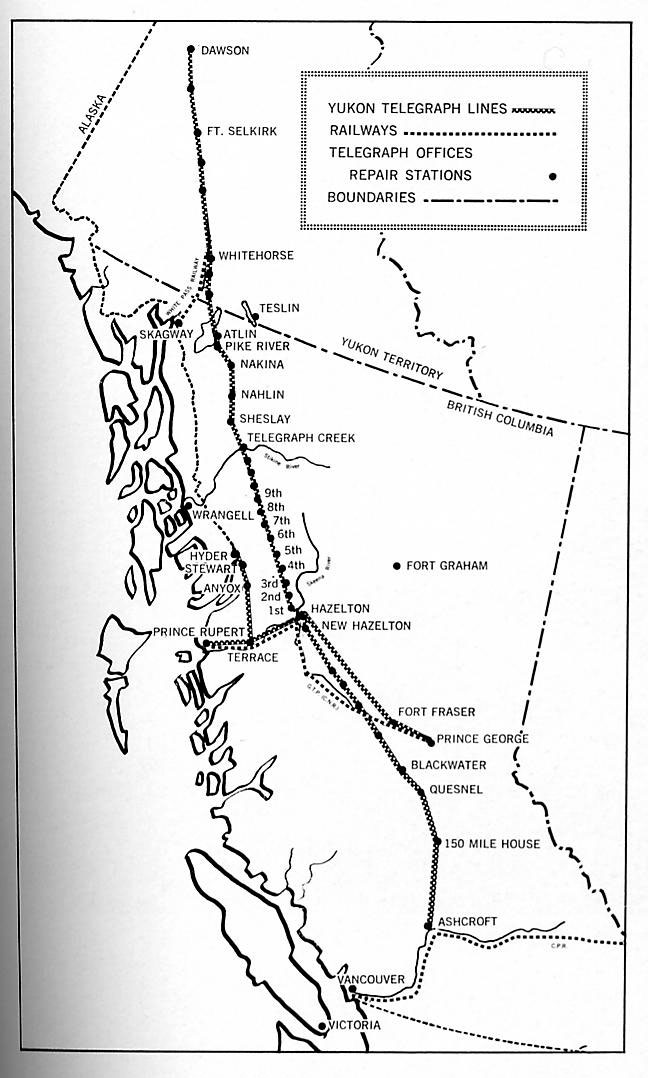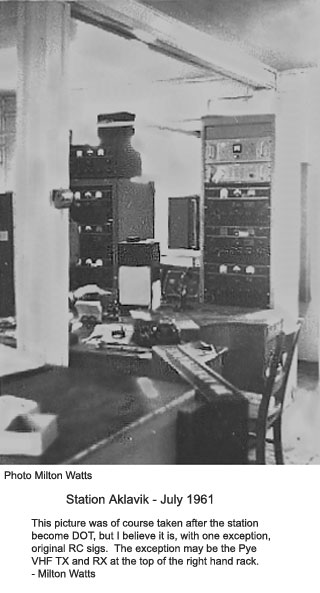The following note on Aklavik and Inuvik stations was received from Spud Roscoe:
[See below - response from Milt Watts]
Ray White and I have been trying to help Jerry Proc with his description of the Naval Radio Station at Aklavik along with a few others. This is the only naval station that was near an N.W.T.& Y station and Jerry has mentioned these stations in this site. I have been trying to figure out what actually took place in the move from Aklavik to Inuvik. I would like to develop "diarrhea" of the keyboard here for a few minutes and see if I can learn something. If anyone does not agree with anything please jump on me and hit Reply All on your machine so we all get a copy.Attached is a map of the Yukon Telegraph Line that the N.W.T. & Y replaced. An act of God in the Yukon required the approval of the White Pass and Yukon Route. If one owned a truck and had a load for the Yukon they stopped at the Yukon border and transferred it to White Pass and Yukon Route equipment or to one of the few trucks that had their permission. There was nothing one could do to go further. Chevron was the only oil and gasoline distributor in the Yukon for many years, the others just could not get permission. The Yukon I visited in 2003 did not remotely resemble the Yukon I lived and worked in forty years before that.I believe this is the reason the N.W.T. & Y went east and down the Mackenzie Delta to Edmonton. This was the area with the companies and private enterprise that needed communications. The second attachment is a list of the N.W.T. & Y stations that had call signs on your web site and I have added the D.O.T. call sign to the ones that were transferred to the D.O.T.The third attachment is a photo of the D.O.T. station at Aklavik taken in 1961 the former RC Sigs station VEF. I wish I had spent more time trying to learn more of this history from Dick Bullock while he and I worked together at Inuvik.For the life of me I cannot see RC Sigs setting up a very elaborate station at Inuvik. I am certain the D.O.T. did not have a station at Inuvik and one at Aklavik. In other words I am convinced Pete Gray operated at Inuvik the 2 and 1/2 years with something like a 19 set on a frequency with VEF Aklavik. I suspect he used call sign VEF1. How many would agree with that? I believe Dick Bullock worked with Pete as a civilian. Dick told me they had an army issue bicycle to deliver messages around town with. One wonders how many days that thing was of any use with the mud on the days of bad sledding, with snow, ice and cold the rest of the time.I am curious about the two pieces of VHF Pye equipment in this photo. We had that equipment in the D.O.T. What the heck would it be used for at Aklavik? Max Ward's fleet consisted of Bristol Freighter CF-TFX, three otters, CF-GBY, CF-ITF and CF-IFP and one Beaver CF-IFJ. TFX had VHF and the others were fitted with their first VHF radio equipment in 1966 while I was operating VFY2 Yellowknife. They had and retained two channels of HF, 5680 and another company frequency on 5 mcs. Gene Goucher, the "old Arctic Fox" of Pacific Western told me they used to use Douglas DC3's, 4's and probably 6's along with other aircraft of similar size, in and out of Shell Lake while they were building Inuvik. Shell Lake is a small lake between the Inuvik Airport and the town. It is shallow and freezes right to the bottom in winter and makes this possible. And of course they had the barges in summer. This VHF equipment must have been for these flights in and out of Shell Lake until the Inuvik Airport went in service.How did you get in and out of Aklavik in 1960 Ray? Did you go to Norman Wells in something like a DC4 and then on to Aklavik on a Beaver on floats or skis?I believe the call sign of this Aklavik station in the photo I pinched from Mike's site is VFA6. I believe that station closed when the station at the Inuvik Airport was more or less in service and that is the reason Inuvik has call sign VFA6. The third letter in most D.O.T. call signs is the first letter of the name of the station.When I operated VFA6 in 1966-67 we were using at least three RCA AT3 transmitters and I was told they came from VEF. I believe VEF used VLF as point to point along with these three transmitters. One of the AT3's was dated 1939 the year I was born and we were very lucky to have them. One used to whistle once in awhile on 5680 kcs and that is the only fault I remember.When I operated on 157 kcs at Teslin VFT2, Coppermine VFU6 was much stronger than Watson Lake VFD and Dease Lake VFD6. So at times these northern RC Sigs stations must have been able to work VED Edmontn direct at times. As you can see a couple of these D.O.T. call signs are not the normal call sign. The U in Coppermine and the D in Watson Lake and a few of the call signs were three letters only.When the D.O.T installed VFA6 at Inuvik they did it with their new Northern Electric transmitters. These Northern Electric transmitters had to be the biggest piece of political purchased junk I ran into in all my life. The damn things killed two of the technicians that were trying to maintain them. They were so bad that no one was to go near them unless they had someone with them. When I wanted VCS Halifax while at sea I simply aimed my receiver in the general direction of their frequency and listened for the "dumb de bumb" sound/tone and rarely bothered to copy the signal unless they did not answer right away.These Northern Electric transmitters would not work at Inuvik because of the louzy electrical grounding due to the permafrost. I am not certain they ever managed to get them to work.Does any of this make any sense or am I just making a nuisance of myself? Can you add or correct to any of this?Spud Roscoe


Note from Milt Watts
This may help clarify Spud Roscoe's comments re Aklavik and Inuvik
First the picture. I took the picture in Aklavik just after installing the Pye VHF equipment. No; it was not used for air/ground It was FM equipment used as a point to point link with Inuvik. I had been assigned to install this system. In Aklavik the antennae, a small Yagi, I think, was mounted on the roof of the building. In Inuvik it was mounted on a pole beside the temporary ,operating point at the airport. Unfortunatley just prior to my trip, some agency had erected a metal sided building directly in the signal path. The system worked, but not well. Travel at that time to Aklavik, was PWA to Inuvik and small floatplane to Aklavik
Aklavik and Inuvik were both operational under the DOT for some time. Aklavik could not be left without some means of communication.
Ted Palamarek was the first DOT operator in Inuvik possibly just before it was turned over to DOT. At that time Inuvik radio was located in one of the many 512's. (512 square foot buildings used for anything and everything in Inuvik East 3.). The station was located in town. I cannot recall the equipment, but I think there was one small lower powered LF transmitter and possibly an AT3, with AR88 receivers. I did not operate at Inuvik, but I was on the crew that relocated it to the airport. I cannot recall seeing a 19 set.
At the airport the temporary operating point was again in a 512. The large main transmitter site was not yet constructed. A small building was built at the airport for transmitters. I do not recall what the LF transmitter was but HF was two AT3 and two or perhaps three TMC GPT750 HF transmitters. The AT3 transmitters could have come from anywhere.
Just a little side note. The DOT were the first occupants of the large DOT/Navy transmitter site. When the crew was first installing equipment they had a surprise. Leaving the building one day a strange zipppp noise occured behind them, turning around they watched one of the long strings of flourescent lights unzipping from the ceiling and crashing to the floor.
Milt Watts
RCCS N.W.T. & Y Call Signs
Taken from their web site and the International Telecommunications Union List of Call Signs. When each station transferred to the Department of Transport the station call sign changed to a Department of Transport Call Sign. A few of the Department of Transport call signs did not have a digit suffix. The Department of Transport station at Tuktoyaktuk did not open until the 1970’s.
VEA Dawson City, Yukon VFD6
VEB Mayo, Yukon VFM8
VEC Fort Simpson, N.W.T. VFF6
VED Edmonton, Alberta VFE
VEE Snare River, N.W.T. closed/did not transfer to D.O.T.
VEFAklavik, N.W.T. (then Inuvik, N.W.T.) VFA6
VEG Fort Smith, N.W.T. VFF3
VEH Fort Resolution, N.W.T. VFR6
VEI FortGoodHope, N.W.T. VFF5
VEJ Ennadai Lake, N.W.T. VFE4
VEK Baker Lake, N.W.T. then Tuktoyaktuk, N.W.T.
Baker Lake, N.W.T. VFB9
Tuktoyaktuk, N.W.T. VYO21
VEL was not assigned to a N.W.T.&Y station – Winnipeg, Manitoba
VEM Yellowknife, N.W.T. VFY2
VEN CameronBay, N.W.T. then Wrigley, N.W.T. VFW6
VEO Hay River, N.W.T. VFH3
VEP Embarras, Alberta VFE3
VEQ Port Radium, N.W.T. – transferred to D.O.T. unable to locate call sign
VER was not assigned to a N.W.T.&Y station – Ottawa, Ontario
VES Fort McMurray, Alberta VFU7
VET Fort Chipewyan, Alberta VFF7
VEU Fort Reliance, N.W.T. VFR7
VEV Norman Wells, N.W.T. VFN8
VEW Fort Providence, N.W.T. – transferred to D.O.T. unable to locate call sign
VEX was not assigned to a N.W.T.&Y station – Penhold, Alberta
VEY Whitehorse, Yukon VFW
VEZ Brochet, Manitoba VFB5
VDI Beaverlodge Lake, Saskatchewan, became Uranium City, Saskatchewan VFB8
Return to top of page
Return to Stories page
Return to Stations page
Go to page [1] [2] [3] [4] [5] [6] [7] [8] [9] [10]